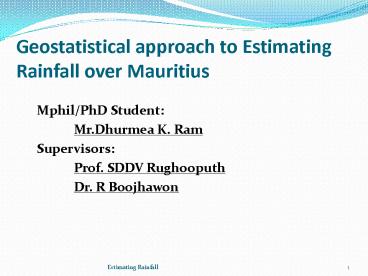Geostatistical approach to Estimating Rainfall over Mauritius - PowerPoint PPT Presentation
1 / 16
Title:
Geostatistical approach to Estimating Rainfall over Mauritius
Description:
Most common technique is geostatistics Special branch of statistics developed by George Matheron (1963) (Centre de Morphologie Mathematique). – PowerPoint PPT presentation
Number of Views:152
Avg rating:3.0/5.0
Title: Geostatistical approach to Estimating Rainfall over Mauritius
1
Geostatistical approach to Estimating Rainfall
over Mauritius
- Mphil/PhD Student
- Mr.Dhurmea K. Ram
- Supervisors
- Prof. SDDV Rughooputh
- Dr. R Boojhawon
2
Objectives of Research
- Analyse qualitatively and quantitatively the
spatial distribution of rainfall over Mauritius. - Develop models for predicting values of rainfall
at other locations from available measured
rainfall values using geostatistics coupled with
regression models. - Generate digital results that can eventually be
used in Geographical Information Systems (GIS).
3
Importance of modelling
- Precipitation measurements are unevenly
distributed over a region and even less in a
mountainous areas. - One of the fundamental problem in hydrology is
to estimate precipitation at unmonitored site
using data from available surrounding
precipitation stations. - Hydrological models require precipitation fields
on grid systems and in digital form.
4
Background work
- Study particularly aim at modelling the
long-term variations in the distribution where
the monthly mean values of precipitation for the
period 1971-2000 are analysed for each month,
i.e. for January till December using
geostatistics.
5
Geostatistics
- Rainfall is also affected by elevation of an
area and also by prevailing atmospheric
conditions - Rainfall is such a variable whose structure
depends on direction (anisotropic). - Need for another method whereby this anisotropic
behavior can be modeled. - Most common technique is geostatistics
- Special branch of statistics developed by George
Matheron (1963) (Centre de Morphologie
Mathematique).
6
VARIOGRAM
- It is the principle tool of geostatistics
- The variogram is a measure of how quickly things
change on the average. - The variogram gives an insight of the geometry
and continuity of the variable - The variogram is a function of direction, i.e. it
characterizes the dependence that exist between
variables at different points in space - The underlying principle on the average, two
observations closer together are more similar
than two observations farther apart.
7
Exploratory data analysis
- Analyze data for trend, outliers and skewness.
- Outliers observed for most of the months.
- No significant trend over short interval but
trend exist over long period. - Data found to be skewed. Square root and log
transformation applied to normalize data. - Modelling is carried out using raw data, outlier
removed data and detrended and transformed data
8
Model Approaches
- Basic geostatisitics model
- Raw data
- Outlier removed
- Transformed data
- Detrended data model
- Raw data
- Outlier removed
- Geostatistical- topographical model
9
Results (1)
- More accurate estimates obtained from detrended
data model. - Better estimates for winter months.
- High error values limited to less than 25 of
the stations. Models yield very good estimates
for 75 of stations. - No improvements in estimates when removing
outliers.
10
Results (2)
- Comparing with the rainfall volume calculated at
the Mauritius Meteorological Services shows that
actually the long term mean monthly rainfall, for
1971-2000, has been underestimated for most of
the months using the isohyetal analysis.
11
Challenges
- Optimize variograms particularly for summer
months to improve accuracy of models - Derive values of humidity, wind speed and
direction, pressure and temperature on a regular
grid from few available stations.
12
Limitations
- Very few stations on mountainous areas.
- Availability of finer resolution Digital
Elevation Model . - Effective estimation of missing rainfall data.
13
Future Works (1)
- To develop individual model templates for
different weather systems. - Include atmospheric variables such as pressure,
temperature, humidity and wind speed and
directions as additional parameters in the
models. - Besides using Ordinary Kriging and regression
models, use cokriging to incorporate the
secondary variables.
14
Future Works (2)
- Model using a smaller number of stations. This
aims at removing redundant, rain gauges and their
relocation. - Implement precipitation forecasting models using
artificial neural networks techniques.
15
Conclusions
- Geostatistics turned is a very good approach for
estimating rainfall. - Accuracy of model estimates depends on degree of
optimisation of variograms.
16
Acknowledgements
- University of Mauritius for providing logistic
support. - Mauritius Research Council for funding this
study. - Mauritius Meteorological Services for providing
required data.































